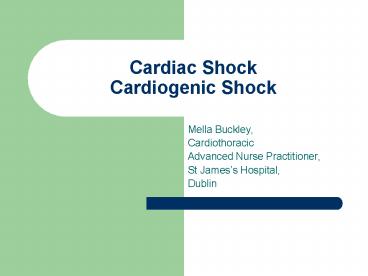Cardiac Shock Cardiogenic Shock - PowerPoint PPT Presentation
1 / 24
Title:
Cardiac Shock Cardiogenic Shock
Description:
Clinical condition resulting from acute generalised state of inadequate tissue ... Decreased mentation. Clinical Manifestations cont. Haemodynamic Findings ... – PowerPoint PPT presentation
Number of Views:10544
Avg rating:5.0/5.0
Title: Cardiac Shock Cardiogenic Shock
1
Cardiac ShockCardiogenic Shock
- Mella Buckley,
- Cardiothoracic
- Advanced Nurse Practitioner,
- St Jamess Hospital,
- Dublin
2
Objectives
- Define Shock
- Cardiogenic Shock
- Etiology/Causes
- Pathophysiology
- Recognise clinical features/clinical
manifestations - Management
- Treatments
- Complications
3
Definition of Shock
- Clinical condition resulting from acute
generalised state of inadequate tissue perfusion
causing tissue hypoxia - Insufficient blood (oxygennutrients) reaching
tissues and insufficient removal of waste from
tissues - Not to be confused with cardiac arrest which is
the acute cessation of the cardiac pump. - Shock can lead to a cardiac arrest.
4
(No Transcript)
5
Different types of Shock
- Hypovolaemic Shock- Fluid loss
- Cardiogenic Shock- Failure of heart to pump
effectively - Distributive Shock- (septic shock, anaphylactic
shock, neurogenic shock)-Peripheral
vasodilatation causing a fall in the volume of
blood returning to the heart
6
Cardiogenic Shock
Failure of the heart to pump effectively
resulting in inadequate circulation of
blood Causes Myocardial Infarct Cardiomyopathy (
Heart muscle disease) Cardiac valve
disorders Congenital defects (ventralseptal
defect) Prolonged cardiopulmonary bypass
7
Etiology
8
Pathophysiology
- Decrease in Cardiac Output
- Fall in blood pressure
- High Left Ventricular Filling Pressures
- Compensatory response
- Increase systemic vascular resistance (increase
blood flow to the heart) - Increase heart rate (increase blood to the
tissues) - Resulting physical manifestations
- Cool peripheries
- Weak thready pulse
- Decreased urine output
- .
9
Signs of decreased tissue perfusion
- Restlessness or decreased conscious level
- Hypotension
- Increased respiratory rate
- Poor urine output
- A weak thready pulse or absent pulse
- Cool, clammy, and mottled skin
- Poor signal on pulse oximeter
- Distended jugular vein
- Fatigue due to hyperventilation
10
Clinical Manifestations
- Radiographic Findings
- Enlarged Heart
- Pulmonary Congestion
- Pulmonary Findings
- Dyspnoea
- Increased respiratory rate
- Inspiratory crackles, possible wheeze
- Arterial blood gases show a low O2
- Respiratory Alkalosis
- Non invasive Findings
- Thready, rapid pulse
- Narrow pulse pressure
- Distended neck veins
- Arrythmias
- Chest pain
- Cool, pale, moist skin
- Oliguria
- Decreased mentation
11
Clinical Manifestations cont.
- Haemodynamic Findings
- Systolic Blood Pressure lt 90 mmHg (sustained gt
30min.) - Mean Arterial Pressure lt70 mmHg
- Cardiac Indexeslt 2.2 L/min/m2
- Pulmonary Artery Wedge Pressure gt 18 mmHg
- Echocardiogram image from a patient with
cardiogenic shock shows enlarged cardiac
chambers
Echocardiogram image from a patient with
cardiogenic shock shows enlarged cardiac
chambers
12
Pulmonary Artery Wedge Pressure
- measured by a Swan-Ganz catheter, is the pressure
measured in a pulmonary artery after occlusion of
that artery. Because of the large compliance of
the pulmonary circulation, it provides an
indirect measure of the left atrial pressure.
13
Cardiac Index
- Cardiac index (CI) is a parameter that relates
the cardiac output to body surface area, thus
relating heart performance to the size of the
individual. Cardiac output is the volume of blood
being pumped by the heart, in particular by a
ventricle in a minute. - The normal range of cardiac index is 2.6 - 4.2
L/min per square meter.
14
Management of Cardiac Shock
- Aim
- Increasing Myocardial Oxygen Delivery
- Maximising Cardiac Output
- Decreasing Left Ventricular Workload
- Treatment
- -Medications
- -IABP
- -Revascularisation
15
Medication
- Fluid Resuscitation if required
- Oxygenation and Airway Protection
- Correct electrolyte imbalance
- Analgesia if required
- Discontinue - Nitrates, beta-blocker and ace
inhibitors as they reduce blood pressure
- Inotropic Agents, increase the force of muscle
contraction - Diuretics, increase the excretion of water and
therefore reduce the workload of the heart - Nitrates once B.P. has stabilised
- Thrombolytic s??? too late
16
IABPmaximise cardiac output
17
Revascularisation
- Percutaneous Transluminal Coronary Angioplasty
- (PTCA)
- or
- Coronary Artery Bypass Grafting
- (CABG)
18
Angiography/Angioplasty
- Following angioplasty of the critical
stenosis, coronary flow is reestablished. The
patient recovered from cardiogenic shock.
- A patient with cardiogenic shock
- demonstrates severe stenosis of
19
Complications of Cardiogenic Shock
- Cardiopulmonary arrest
- Dysrythmias
- Renal failure
- Multisystem Organ Failure
- Ventricular Aneurysm
- Stroke
- Death
20
The downward spiral in cardiogenic shock
Hollenberg, S. M. et. al. Ann Intern Med
199913147-59
21
Mortality
- gt 55 inpatients treated medically die from
cardiogenic shock
22
Conclusion
- Cardiac shock is life-threatening
- The key to successful management is early
diagnosis and prompt medical management - Be aware of the signs of decreased tissue
perfusion - Assess total perfusion (peripheries, urine
output) and not simply blood pressure
23
References
- Towbin JA, Bowles NE. The failing heart. Nature
2002415(6868)227-33. - Sommers MS. The cellular basis of septic shock.
Crit Care Nurs Clin North Am 200315(1)13-25. - Moore PR, Kharbanda R, Banner NR. Acute heart
failure and cardiogenic shock. Br J Hosp Med
(Lond) 200869(1)8-12. - http//www.emedicine.com/med/TOPIC285.HTM
- Marino, P.L. The ICU Book 3rd Ed. 2007 Lippincott
Williams and Wilkins - Hudak, C.M. Critical Care Nursing A Holistic
Approach 8TH Ed. 2005 Lippincott Williams and
Wilkins
24
Any Questions?

